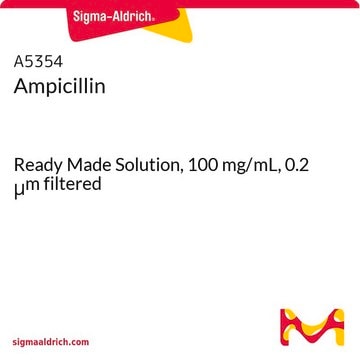A9518
Ampicillin sodium salt
Synonym(s):
D-(−)-α-Aminobenzylpenicillin sodium salt
About This Item
Recommended Products
biological source
synthetic (chemical)
Quality Level
form
powder
color
white to off-white
mp
215 °C (dec.) (lit.)
solubility
water: 50 g/L
antibiotic activity spectrum
Gram-negative bacteria
Gram-positive bacteria
application(s)
agriculture
Mode of action
cell wall synthesis | interferes
storage temp.
2-8°C
SMILES string
[Na+].CC1(C)SC2[C@H](NC(=O)[C@H](N)c3ccccc3)C(=O)N2[C@H]1C([O-])=O
InChI
1S/C16H19N3O4S.Na/c1-16(2)11(15(22)23)19-13(21)10(14(19)24-16)18-12(20)9(17)8-6-4-3-5-7-8;/h3-7,9-11,14H,17H2,1-2H3,(H,18,20)(H,22,23);/q;+1/p-1/t9-,10-,11+,14-;/m1./s1
InChI key
KLOHDWPABZXLGI-YWUHCJSESA-M
Looking for similar products? Visit Product Comparison Guide
Related Categories
General description
Application
- to select for ampicillin resistance in mutated and transformed cells
Biochem/physiol Actions
Mode of Resistance: Administration with ß-lactamase cleaves the ß-lactam ring of Ampicillin and inactivates it.
Antimicrobial Spectrum: Includes both gram-positive (similar to benzylpenicillin) and gram-negative bacteria (similar to tetracyclines and chloramphenicol.
Features and Benefits
- High-quality antibiotic suitable for multiple research applications
- Ideal for Cell Biology and Biochemical research.
Caution
Preparation Note
Storage and Stability
Other Notes
comparable product
related product
Signal Word
Danger
Hazard Statements
Precautionary Statements
Hazard Classifications
Resp. Sens. 1A - Skin Sens. 1A
Storage Class Code
11 - Combustible Solids
WGK
WGK 3
Flash Point(F)
Not applicable
Flash Point(C)
Not applicable
Personal Protective Equipment
Choose from one of the most recent versions:
Certificates of Analysis (COA)
Don't see the Right Version?
If you require a particular version, you can look up a specific certificate by the Lot or Batch number.
Already Own This Product?
Find documentation for the products that you have recently purchased in the Document Library.
Customers Also Viewed
Articles
Overview on how to maintain proper cell culture laboratory safety including steps on performing lab risk assessments, surface disinfection, biohazard and waste removal. Free ECACC handbook download.
Our team of scientists has experience in all areas of research including Life Science, Material Science, Chemical Synthesis, Chromatography, Analytical and many others.
Contact Technical Service








